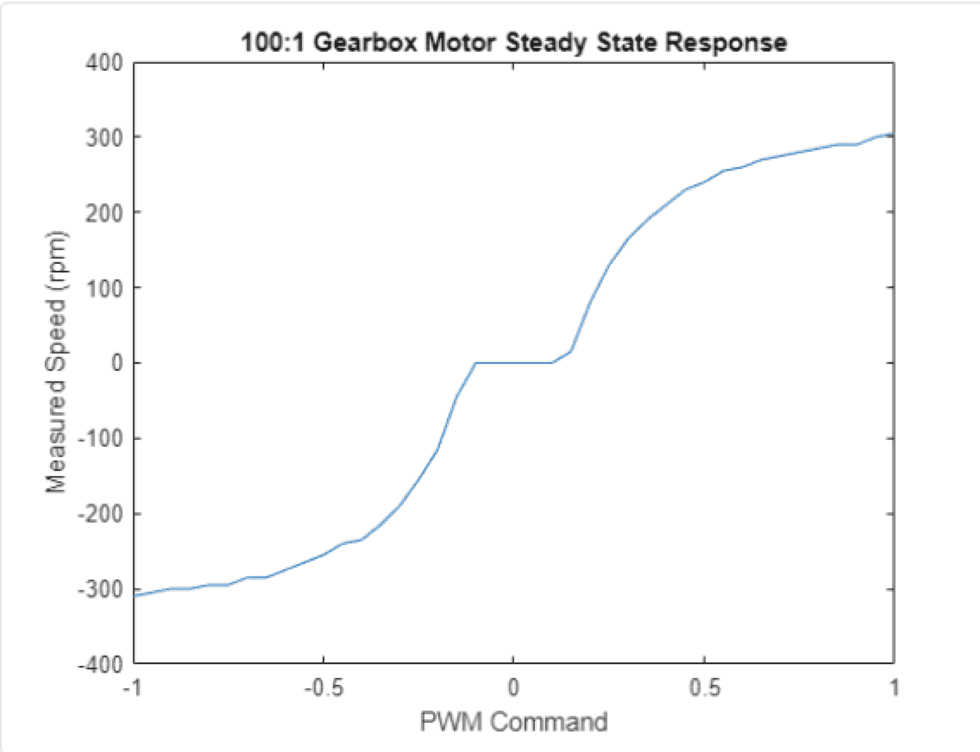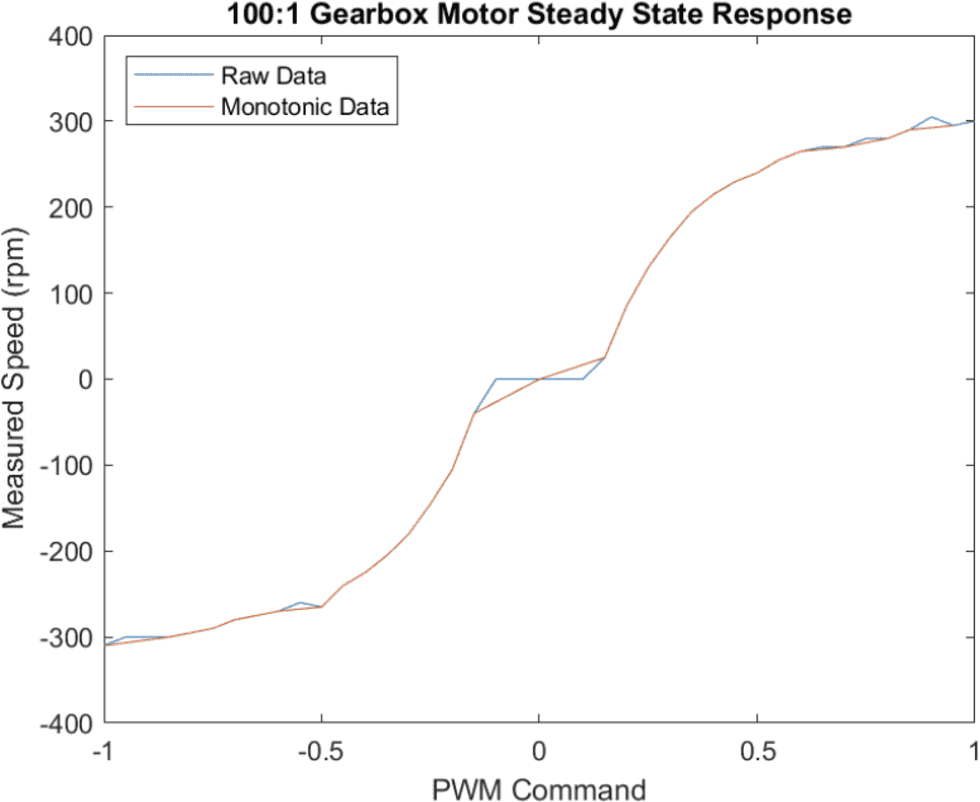Measure the relation between PWM Duty Cycle and Speed
%% 1. Create test data
maxPWM = 1.00; % Maximum duty cycle
incrPWM = 0.05; % PWM increment
PWMcmdRaw = (-maxPWM:incrPWM:maxPWM); % Column vector of duty cycles from -1 to 1
speedRaw = zeros(size(PWMcmdRaw)); % Initialize a vector for speed raw reads%% 2. Create and initialize device objects
clear a dcm carrier enc % Delete existing device objects
a = arduino;
carrier = motorCarrier(a);
dcm = dcmotor(carrier,'M1'); % Connect a DC motor at 'M1' port on the Arduino Nano Motor Carrier board
enc = rotaryEncoder(carrier,1); % Connect the encoder of 'M1' at the encoder port 1 on the Arduino Nano Motor Carrier boardColumn vector of duty cycles from -1 to 1%% 3. Measure raw motor speed for each PWM command
dcm.Speed = 0;
gearRatio = 100; % As per the motor spec sheet, gear ratio equals 100:1
start(dcm) % turn on motor
dcm.Speed = PWMcmdRaw(1); % this assigns the first value to dcm.Speed
pause(1) % wait for steady state
speedRaw(1) = readSpeed(enc)/gearRatio; % read motor speed in rpm of the output shaft
stop(dcm); % turn off motor
dcm.Speed = 0; After running this section, the DC motor will run at max speed (-1) for 1 second and stop. Array - speedRaw will record the encoder counter read.
To measure all possible values, we use for-loop:
%% 3. Measure raw motor speed for each PWM command
dcm.Speed = 0;
gearRatio = 100; % As per the motor spec sheet, gear ratio equals 100:1
start(dcm) % turn on motor
for ii = 1:length(PWMcmdRaw)
dcm.Speed = PWMcmdRaw(ii);
pause(1) % wait for steady state
speedRaw(ii) = readSpeed(enc)/gearRatio; % read motor speed in rpm of the output shaft
end
stop(dcm) % turn off motor
dcm.Speed = 0;Now visualize the result:
%% 4. Graph raw data
plot(PWMcmdRaw,speedRaw) % raw speed measurements
title('100:1 Gearbox Motor Steady State Response')
xlabel('PWM Command')
ylabel('Measured Speed (rpm)')Post-Process Speed Measurements to remove "Dead Zone"
To create a motor control system, in which a user will request a motor speed in rpm and system gives the PWM duty value, we need to remove repeated values.
%% 5. Post-process and save data
idx = (diff(speedRaw) > 0) % speedRaw is 1x41 vector. diff calculates the
% difference between 2 consecutive values. idx
% is a 1x40 vector containing 1 and 0. 1 means at
% that index, the diff is not 0.
speedMono = speedRaw(idx); % speedMono is a sub-set of speedRaw with different
% values
PWMcmdMono = PWMcmdRaw(idx);
PWMcmdMono(speedMono == 0) = 0; % enforce zero power for zero speed
save motorResponse PWMcmdMono speedMono % save post-processed measurements%% 6. Graph raw and post-processed data
plot(PWMcmdRaw,speedRaw) % raw speed measurements
hold on
plot(PWMcmdMono,speedMono) % non-monotonic measurements filtered out
title('100:1 Gearbox Motor Steady State Response')
xlabel('PWM Command')
ylabel('Measured Speed (rpm)')
legend('Raw Data','Monotonic Data','Location','northwest')%% 6. Delete device objects
clear a dcm carrier encCreating Matlab Functions
By creating "live function", we can manage reusable functions by defining:
function [PWMcmdMono,speedMono] = myMotorFunction(PWMcmdRaw,dcm,enc)With the help of this function, section 3-6 can be replaced by one line of function call.
In the tutorial, to save data to work place, it uses
save(filename, 'vector-1', 'vector-2'). However, it looks like it does not work in my workplace. I need to change it tosave filename vector-1 vector-2.
With the file myMotorCharacterization.mlx and myMotorFunction.mlx, we can run clear then myMotorCharacterization in the command window to reuse the characterization funcion. PWMcmdMono and speedMono will be saved in motorResponse.mat file.

